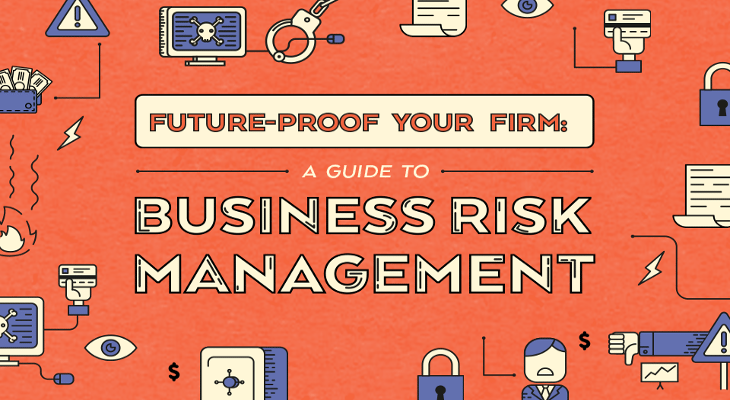While it’s easy to focus on the positives of your growing business, what about mitigating risks for the future? Every company—whether it’s a fledgeling startup, a growing SME or a booming multinational—should be continually figuring out how to react and adjust to whatever curveballs the business world hurls in its direction. Proactive business risk management is the only way to truly future-proof your success. Done properly, it may even drive revenue, help secure new markets and attract new clients.
It’s hard to know where to begin, but the following Guide to Business Risk Management breaks down the risks into six main categories: financial risk, operational risk, regulatory risk, cyber security, reputational risk and physical danger.
Below, learn more about each of the six types of business risks you need to know about:
Financial risk
Financial risk is a high priority for any business and as such, is perhaps the first one that most people think about. It’s an overarching term for the kinds of risks that lie in your company’s finances. Examples include fluctuating exchange rates, movements in stock prices, cash flow handling and loans at risk of default.
Don’t forget that as your business expands, the financial risks will grow in parallel.
Operational risk
Not all risk comes from outside. Operational risk is the type that arises from human error or misjudgement within your organization. The good news, though, is that it is much easier to anticipate and develop safeguards against internal risks than external ones.
Managing operational risk therefore overlaps significantly with the management of reputational risk, particularly in industries where social media is a forum for public outreach. Training employees in best-practice public relations is important, but it is also crucial to have the right tools and apps to both monitor your online reputation and craft a digital presence that consumers find appealing.
Also on StartupNation.com: How to Manage Business Insurance
Regulatory risk
Regulatory risk is the threat that changes in laws and regulations and will have a negative impact on your business. Ignoring or missing such changes can increase the costs of your operations, reduce the attractiveness of an investment or change the competitive landscape.
In the worst cases, it can mean serious penalties and criminal proceedings. As such, it’s vital to keep on top of new rules that will directly and indirectly affect your company.
Cyber security
Companies everywhere are being targeted by hackers, regardless of size, industry and turnover. This is a booming area of risk and it should be of concern to any company which uses an internet connection. Hackers are especially starting to focus on cloud-based systems and infrastructure, which are now being used by more and more organizations.
Employees need to be educated in safe use of the web, company data needs to be protected, as does the personal information of customers. Developing counter-measures which satisfy the ISO/IEC 27001 international information security management standard is a good place to begin.
Reputational risk
Often, it’s only once lost that companies realize the true value of their reputation. Reputational risk describes the risk of damage to a firm’s reputation, and often involves ethics, safety, sustainability and security. Extreme cases may even lead to bankruptcy. It can be the result of many factors, including the actions of the company or its employees, or indirectly, through partners and suppliers.
Physical risk
Risks to buildings, property and physical assets sit within the sphere of physical risk. Fire or explosions are the most common risks to a building, much of which can be overcome with suitable planning and emergency procedures. Some companies may also need to consider the impact of hazardous material spills.
Business risk management: take action now
Creating a risk management plan for your company is a necessary first step. Start by ranking a list of possible threats, which will enable you to prioritize and assign resources to each area of risk. This is the time to consider the potential outcomes, estimate the assets in danger and identify the sources of each threat.
This “risk register” is never finished and should remain an active document that you consult and update regularly.






